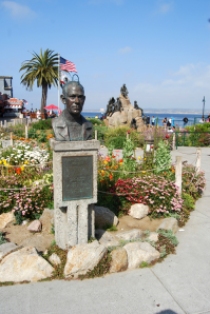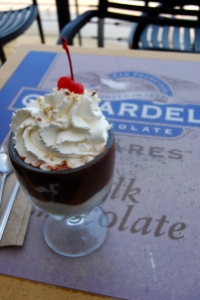“Cannery Row in Monterey in California is a poem, a stink, a grating noise, a quality of light, a tone, a habit, a nostalgia, a dream. Cannery Row is the gathered and scattered, tin and iron and rust and splintered wood, chipped pavement and weedy lots and junk heaps, sardine canneries of corrugated iron, honky tonks, restaurants and whore houses, and little crowded groceries, and laboratories and flophouses.”
 John Steinbeck’s description of Monterey during its industrial heyday paints a very different work of art than visitors find today. Now stuffed with boutique hotels, fine dining establishments and gift shops, only the old canneries hearken back to the Silver Tide while walking down the former Ocean View Avenue today. But, I guess it’s okay to swap out the stink and grating noise for chocolatiers and street performers.
John Steinbeck’s description of Monterey during its industrial heyday paints a very different work of art than visitors find today. Now stuffed with boutique hotels, fine dining establishments and gift shops, only the old canneries hearken back to the Silver Tide while walking down the former Ocean View Avenue today. But, I guess it’s okay to swap out the stink and grating noise for chocolatiers and street performers.
Ironically, after several decades as an industrial fishing and canning district, the area has returned to what some of the earlier inhabitants wanted it to be—a riveria of the Central California Coast. Only now, it has a rich history immortalized by one of America’s greatest authors in his novel that christened the street Cannery Row.
 In my opinion the crown jewel of the district is the aquarium at the end of the row, but more about that in the next post. For now, let me share a bit more about the rest of my time in Monterey’s most famous neighborhood.
In my opinion the crown jewel of the district is the aquarium at the end of the row, but more about that in the next post. For now, let me share a bit more about the rest of my time in Monterey’s most famous neighborhood.
In addition to the fluff and clutter of everything tourist, the city and Cannery Row Foundation has done a very good job of maintaining a bit of the history and story that makes this place worth the time and energy.
Next to the aquarium is Ed Rickett’s marine biology laboratory. While mostly everyone else was canning fish, “Doc” as he was known in Steinbeck’s fiction was studying and learning as much as he could about the ocean and bay environment. He collected specimens and observed the way everything worked together. His little shack is dwarfed between two giant canneries and backs up right to some tide pools he undoubtedly studied quite vigorously.
 From the little walkway that takes you by the lab, you can walk behind the buildings on a lovely little path with amazing views of the bay. There are plaques along the route telling the stories of Monterey. It is also a little more peaceful down this back path then out in the hubbub of the main drag.
From the little walkway that takes you by the lab, you can walk behind the buildings on a lovely little path with amazing views of the bay. There are plaques along the route telling the stories of Monterey. It is also a little more peaceful down this back path then out in the hubbub of the main drag.
About midway down the row is a little plaza named after Steinbeck. In the center is a fountain sculpture with the characters from his book. Again there are grand views out to sea and a sandy beach down below, which was alive with activity when I was there.
 Just above the beach was my next destination—Ghirardelli Ice Cream & Chocolate Shop—for an absolutely delectable hot fudge sundae.
Just above the beach was my next destination—Ghirardelli Ice Cream & Chocolate Shop—for an absolutely delectable hot fudge sundae.
As I continued down the row, I came to a small beach wedged between two old cannery buildings and set off from the street. I’d recommend this patch of sand if you want a more serene place to sit and meditate on the bay.
Then just a bit further I came to a much larger public beach with lots of amenities for picnickers and others wanting to enjoy themselves outside. Supposedly, this is a popular beach for launching kayaks and scuba diving. It is just next to the largest collection of California sea lions I’ve seen outside of Pier 39 in San Francisco. You can find them on either side of the U.S. Coast Guard pier. They’re swimming, sunbathing, barking, and the younglings are super cute.
After my walk along Cannery Row, I went to meet my sister and her family at Fisherman’s Wharf for some fish and chips. To get there, I walked along a lovely path that skirted the bay. I enjoyed harbor seals and more as I meandered down this path.

Monterey has a rich history that’s definitely worth exploring. As you’ll see just off of Fisherman’s Wharf, this is considered by many to be the oldest official settlement in California with the oldest government buildings being the custom house. The city has history going back hundreds of years with the Native Americans who fished in the bay. They were followed by the Spanish with a beautiful old church and presidio.
One of the largest Chinese settlements in the United States was here for many years. Pirates took over at one time. And, the Silver Tide provided food for two world wars, work through the Great Depression, innovations in the fishing and canning industry, volumes of knowledge about the marine ecosystem, and fish fertilizer used in the Heartland for crops and feeding livestock.
With such fascinating and colorful history, Monterey has so much more to offer than just the pleasant climate of Central California. Be sure to take some time exploring what made the area what it is today, and don’t forget to wave to this little guy when you’re there!








From Canned Fish to Seafood Watch | Adventure Patches
[…] highlight of Cannery Row for me is the world-class Monterey Bay Aquarium, which highlights the vibrant life of the bay it is […]